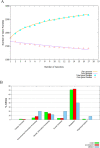Reverse vaccinology approach to identify novel and immunogenic targets against Porphyromonas gingivalis: An in silico study
- PMID: 36040920
- PMCID: PMC9426909
- DOI: 10.1371/journal.pone.0273770
Reverse vaccinology approach to identify novel and immunogenic targets against Porphyromonas gingivalis: An in silico study
Abstract
Porphyromonas gingivalis is a primary causative agent of chronic periodontitis. Moreover, it leads to several systemic diseases, including rheumatoid arthritis, cardiovascular, neurodegenerative, and Alzheimer's diseases. It seems that the development of a vaccine against this bacterium is necessary. Thus, this study decided to identify novel immunogenic targets and developed multiple epitope-based vaccines against P. gingivalis. For this purpose, the pan/core-proteome of this bacterium was studied, and the suitable vaccine targets were selected based on different properties, including exposed localization of proteins, antigenicity, non-allergenicity, non-similarity to host proteome, stability, B-cell epitopes and MHC II binding sites, sequence conservation, molecular docking, and immune simulation. Through the quartile scoring method, 12 proteins with ≥ 20 scores were considered as suitable immunogenic targets. The results of the protein domain and functional class search showed that most of the immunogenic proteins were involved in the transport and metabolism of inorganic ions and lipids. In addition, two unknown function proteins, including WP_004584259.1 and WP_099780539.1 were detected as immunogenic targets. Three constructions carrying multi-epitopes were generated including Naked, LCL, and as chimeric structures. Among them, FliC chimeric protein had the strongest affinity to the human TLR2, 4, and 6, while the LCL platform represented the highest level of immune stimulation response. The obtained results from this study revealed new insights into prophylactic routes against P. gingivalis by introducing novel immunogenic targets. However, further investigations, including site-directed mutation and immunoassay are needed to confirm the pathogenic role and protectivity of these novel proteins.
Conflict of interest statement
The authors declare that they have no competing interests.
Figures






Similar articles
-
Identification of novel putative immunogenic targets and construction of a multi-epitope vaccine against multidrug-resistant Corynebacterium jeikeium using reverse vaccinology approach.Microb Pathog. 2022 Mar;164:105425. doi: 10.1016/j.micpath.2022.105425. Epub 2022 Jan 31. Microb Pathog. 2022. PMID: 35114352
-
Proteome-wide mapping and reverse vaccinology-based B and T cell multi-epitope subunit vaccine designing for immune response reinforcement against Porphyromonas gingivalis.J Biomol Struct Dyn. 2022 Feb;40(2):833-847. doi: 10.1080/07391102.2020.1819423. Epub 2020 Sep 14. J Biomol Struct Dyn. 2022. PMID: 32928063
-
A reverse vaccinomics approach for the designing of novel immunogenic multi-epitope vaccine construct against gas gangrene and related colorectal cancer for Clostridium septicum DSM 7534.Hum Immunol. 2024 Nov;85(6):111169. doi: 10.1016/j.humimm.2024.111169. Epub 2024 Nov 8. Hum Immunol. 2024. PMID: 39514991
-
Integrating core subtractive proteomics and reverse vaccinology for multi-epitope vaccine design against Rickettsia prowazekii endemic typhus.Immunol Res. 2024 Feb;72(1):82-95. doi: 10.1007/s12026-023-09415-y. Epub 2023 Aug 22. Immunol Res. 2024. PMID: 37608125
-
Investigation of novel putative immunogenic targets against Staphylococcus aureus using a reverse vaccinology strategy.Infect Genet Evol. 2021 Dec;96:105149. doi: 10.1016/j.meegid.2021.105149. Epub 2021 Nov 18. Infect Genet Evol. 2021. PMID: 34801756
Cited by
-
Revolutionizing Dentistry: Preclinical Insights and Future Applications of mRNA Vaccines in Dentistry-A Narrative Review.Dent J (Basel). 2025 Feb 13;13(2):79. doi: 10.3390/dj13020079. Dent J (Basel). 2025. PMID: 39996953 Free PMC article. Review.
-
Defeating a superbug: A breakthrough in vaccine design against multidrug-resistant Pseudomonas aeruginosa using reverse vaccinology.PLoS One. 2023 Aug 3;18(8):e0289609. doi: 10.1371/journal.pone.0289609. eCollection 2023. PLoS One. 2023. PMID: 37535697 Free PMC article.
-
Unveiling promising immunogenic targets in Coxiella burnetii through in silico analysis: paving the way for novel vaccine strategies.BMC Infect Dis. 2023 Dec 21;23(1):902. doi: 10.1186/s12879-023-08904-7. BMC Infect Dis. 2023. PMID: 38129801 Free PMC article.
References
-
- Khan S, Ali SS, Zaheer I, Saleem S, Ziaullah, Zaman N, et al.. Proteome-wide mapping and reverse vaccinology-based B and T cell multi-epitope subunit vaccine designing for immune response reinforcement against Porphyromonas gingivalis. Journal of Biomolecular Structure and Dynamics. 2022;40(2):833–47. doi: 10.1080/07391102.2020.1819423 - DOI - PubMed
MeSH terms
Substances
LinkOut - more resources
Full Text Sources
Molecular Biology Databases
Research Materials

